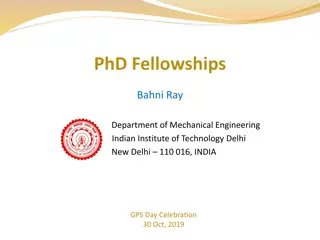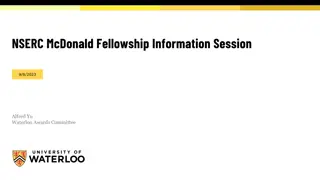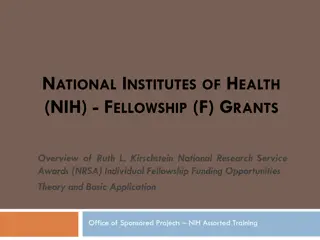India Fellowship Seminar on Participating vs. Non-participating Products
The seminar delved into the role of participating and non-participating insurance products in premium growth, risk management, and creating shareholder value in the long term. It discussed market trends, historical data, and key drivers influencing shareholder value in the Indian insurance industry.
Download Presentation

Please find below an Image/Link to download the presentation.
The content on the website is provided AS IS for your information and personal use only. It may not be sold, licensed, or shared on other websites without obtaining consent from the author. Download presentation by click this link. If you encounter any issues during the download, it is possible that the publisher has removed the file from their server.
E N D
Presentation Transcript
28th India Fellowship Seminar Participating products contribution to premium growth, risk management and shareholders value in long term vis. a vis. non- participating products Guide Name: Sachin Saxena Presenters Name: 1. Aditya Mall 2. Ritu Dabral 3. Aditi Goel Date November 10, 2017 Mumbai Indian Actuarial Profession Serving the Cause of Public Interest
Agenda 1 Market in India 2 Drivers of Shareholders Value What are we discussing today 3 PAR vs NPAR Attractions 4 Creating Shareholder Value 5 Risk Management PAR vs NPAR www.actuariesindia.org 2
Market History - Business written in India 99% of the business written by LIC is Non Linked Before privatization participating product was dominating the market 2004-2010 - private players started turning away from participating business ULIP offered front loadings of expenditures Equity market boom Private Insurers mix in last three Financial Years 2010-2013 regulatory changes Leading to decline in ULIP Focus more on conventional business particularly participating Non Linked 45% Linked 55% www.actuariesindia.org 3 Data Source IRDAI Handbook FY 2015-16
Market Statistics Private players business comparison NB Volume - FY 2015-16 Leaders in private sector backed by bank distribution channel are majorly selling ULIP s 100% 80% 60% 40% Small private players are focusing more on NPAR business 20% 0% ICICI SBI Max IDBI Bajaj DHFL Edelweiss Star Union Dai-ichi Compare to last year the PAR business mix has declined where as NPAR mix has been stable PAR NPAR ULIP NB Volume - FY 2016-17 100% 80% Business mix strategy is mainly driven by - 60% 40% Distribution channel Product profitability Capital support Target market 20% 0% ICICI SBI Max IDBI Bajaj DHFL Edelweiss Star Union Dai-ichi www.actuariesindia.org 4 Data Source Public Disclosures
Key Drivers to Access Shareholder Value New Business Margin Shareholder Value PAR NPAR : 30% - 50% ULIP : 5% - 8% : 10%-15% New Business Profitability Earning Volatility as experience evolve Capital Requirement over long run Low Low Low PAR High High High NPAR Low High High ULIP www.actuariesindia.org 5
Emergence of profits with contract duration Whilst 90 :10 profit sharing gate applicable to participating fund limits NBM for PAR products, 100% profit allocation to shareholders under 0:100 fund structure for Non-PAR products renders comparatively much higher NBM The graph below shows a comparison of the pattern of shareholder transfer emergence expected on a hypothetical Par contract vis- -vis a Non-PAR contract Comparision of Shareholder Transfers between PAR & Non-PAR Key Outcomes PAR starts generating shareholder transfers from the first year itself transfer linked to 1/9th cost of bonus, not surplus emerging in fund 1 2 3 4 5 6 7 8 9 10 NPAR generates large losses in first year due to strain Shareholder trfs under Non-PAR Shareholder trfs under PAR Further, losses also result in depletion of the insurer s solvency capital thereby necessitating the need for further capital. Assumptions Insurer has existing par fund Bonus strategy is low RB high TB www.actuariesindia.org 6
Participating vs Non Participating Challenges Understanding of the business and its complexity Risk and Return Some of the newer private insurance companies don t have existing Par Funds Lower capital requirement Initial reserving strain/temporary deficits would require contributions from the shareholder fund, which would irrevocably be locked in even after the deficits reverses Sharing of experience Attraction Application of significant levels of bonus smoothing is relatively difficult until the par funds build up critical mass Smoothed investment return Discretionary benefits Policyholder s reasonable expectations www.actuariesindia.org 7
Capital Calls PAR - Reserves built up gradually as bonuses are declared PAR Capital injection permissible for only first 12 years of operation NPAR - Higher initial reserves due to implied guarantees leading to higher capital strain NPAR - No such regulatory restriction Capital Strain Capital Injection PAR - Transfers to shareholders - 10% of distributable surplus - Initial capital locked-in. Cost of capital may be charged to PAR fund. Distribution of Surplus / Return on Capital PAR - On built up of Par estate, it becomes self supportive and support solvency Self- Supportive fund NPAR - In long run, In- force profit expected to fuel new business growth engine NPAR - 100% profit allocation to SH. www.actuariesindia.org 8
Earning Volatility - Risk vs. Return Leveraged play Higher expected returns Higher Volatility prospective Investors. Poor perception of management Higher risk Not preferred by shareholders, regulators, analysts and Questions financial stability Participating Business Non-participating Business Discretionary nature of policy benefits limits downside, subject to PRE. Policy benefits are guaranteed, thus insurer has no discretion. 90:10 profit sharing gate limits shareholders exposure to experience variance. Policyholders neither participate in upside nor downside of experience variance. Hence, any experience variance 100 % borne by shareholders. Most vulnerable to managing PRE, particularly if fund estate insufficient to absorb losses. Most vulnerable to reinvestment and persistency risk. Profits are low but smooth and less volatile. Profits are high but can be very volatile, particularly for young and small players. www.actuariesindia.org 9
Building Long-term Shareholder Value Product / Technology innovation award competitive advantage and boosts top line. Thriving for Innovation Business efficiencies in terms of cost budgeting, higher service standards improve bottom line. Optimizing investment portfolio, bearing nature of liabilities in mind, enhances SH s return. Exploring Business Efficiencies Creating Value Expanding Expansion continuous lookout for business opportunities Developing new cost-efficient distribution channels such as banks. Optimizing Investment Strategy Merger & Acquisition opportunities. Acquiring another financial institution. www.actuariesindia.org 10
Management Practices: Creating or Eroding Shareholder Value? Particulars Participating Products Non-Participating Products Investment Strategy / Equity Backing Ratio (EBR) Aggressive bonus strategy (High RB) Coupled with high EBR Writing significant guarantees Coupled with high EBR Expense Management EOM 2016 requirement of segment level monitoring restricts expenses that can be charged to fund Extremely important to eliminate expense overrun above targeted expenses Speed of Responding to External factors / Seizing opportunities Given complex nature of product, it takes time to roll out new product Results in delayed response and loss of market premium Relatively simple to design and launch new product Merger and Acquisition Induces complications due to obligation to balance interest between SH & PH No such complications. Product / Technology Innovation Differentiated bonus structures possible. Automation can reduce operational hassles Differentiated products possible. Tech innovation for ease of selling Managing PRE Discretionary nature does provide flexibility but also comes with responsibility to protect PH s interest PRE limits ability to adjust bonuses to desirable level under adverse scenarios Benefits are guaranteed, hence it is relatively less prone to PRE However PRE arises in context of special surrender value, claim settlement and service standards. www.actuariesindia.org 11
Risk Management Framework : Introductory Key objective of having appropriate controls and procedures:- To provide management with adequate means of managing risks Enable them to make well informed business decisions with regard to risks and available financial resources An ultimate aim of protecting policyholder s interest and shareholders value Should have a well documented board approved risk management policy, regularly reviewed. Clearly articulated key risk appetite measures such as target & minimum solvency ratio / profitability measures etc. Risk management process should involve four steps approach towards addressing risks across the company www.actuariesindia.org 12
Examples of risk that need to be managed Operational risk Insurance Risk Economic risk - Mortality/longevity - Persistency - Expenses - Equity falls - Yield curve changes - Implied volatility changes - Credit spreads & defaults - Non-compliance with PPFM - Errors e.g. in asset share calculations - Exercising discretion - Process failure www.actuariesindia.org www.actuariesindia.org 13 13
Risk Management - Economic Risk Economic risk will hold true for all categories of products. Asset Liability Management is critical for the sound management of the any organization that invests to meet its future cash flow needs and capital requirements The implied guaranteed are much higher in non-par when compared to par. Hence, economic risk is much higher in case of non-par contracts. Equity fall Reducing EBR is the first and simplest mechanism to manage risk Diversifying investment exposures to get highest expected returns for given level of volatility Credit spreads & defaults Reduce concentration of assets Invest in high rated bond Depend on risk appetite of the company www.actuariesindia.org www.actuariesindia.org 14 14
Risk Management - Economic Risk Market Volatility Hedging can be used to mitigate volatility in market More frequent rebalancing of investments and hedges - can be expensive - might set trigger points for extra reviews rather than having more frequent reviews More frequent reviews of bonus rates - this may undermine the smoothing Low Yields Using derivatives to mitigate reduction in yield Review investment strategies to optimise returns Trade off against liquidity when assets with higher expected returns are less liquid Consider relative costs and benefits of alternative strategies: - reduce risk exposure vs high risk exposure + risk mitigation www.actuariesindia.org www.actuariesindia.org 15 15
Considerations under Economic Risk General Considerations Capital market constraints Instrument liquidity & costs Exchange vs OTC Cash flow impact and uncertainty - surrenders Systems, processes and resources (expertise) Proper governance practise and controls are in place With-Profits Specific Considerations EBR considerations: do they meet the PRE Management Actions - Losses shared with par fund: by way of bonus rate reductions - Losses absorbed by participating fund estate, if any: no change in the bonus rate - If participating fund estate is insufficient: company may bear the losses Any changes to bonus rates need to allow for PRE www.actuariesindia.org www.actuariesindia.org 16 16
Risk Management - Insurance risk Company exposed to the risk that the experience of mortality, expenses and persistency is adverse relative to best estimate. This holds true for all categories of products Non - Participating Insurance risk borne by the Company Participating Insurance risk borne by the Company s participating fund - passed through in the form of bonus rate reductions - if expenses high on account of acquisition costs cannot be charged to AS - may need to be absorbed by estate of the participating fund, if any. losses may be absorbed by the participating fund estate, if any - no change in the bonus rate if participating fund estate is insufficient - cannot be passed as bonus rate reductions, company will bear losses These are subject to competitive and PRE considerations www.actuariesindia.org www.actuariesindia.org 17 17
Risk Management - Insurance risk mitigations Underwriting Incorporate reinsurance Emphasis on expenses management and controls Outsourcing Emphasis on increasing persistency need based selling product design proactively calling customer improve administration efficiencies, etc. Monitor regularly Management information - Regularly report on exposure movements and claims Re-pricing www.actuariesindia.org www.actuariesindia.org 18 18
Risk Management - Operational risk Risk of failure of governance leading to insolvency Loss of PH confidence Loss of company reputation All product category exposed to risk like frauds, mis-selling, calculation errors, process failures, etc. Use of derivatives also introduce additional operation risk e.g. people, process, technology, etc Risk of forming unrealistic PRE Unrealistic product benefits promised Claim procedures ease of claim payout However, par products have higher operations risk Large areas of discretion available to the company Inaccuracies in Asset Share and bonus calculation Unrealistic bonus expectations set Mismatch between PH expectation and actual investments . www.actuariesindia.org www.actuariesindia.org 19 19
Risk Management: Operational risk mitigations General Mitigations \ Underwriting to prevent Fraud Increase customer awareness - Absolute clarity in all documents to avoid mis-selling - Published policy on dealing with complaints: escalation matrix and contact details - Timely turnaround of policyholder servicing requests to meet PRE Robust systems and processes for policy administration in place Internal Audit Mitigations Specific to With-Profits Appropriate and fair allocation of expenses to Par funds - Detailed description in which expenses allocated to Par funds and drivers being adopted - Expenses illustrated in BI should gets charged into AS Detail review by with profit Actuary With Profit Committee to approve the asset shares and to produce a report to be appended to the AA s Report submitted to IRDAI Board approved bonus philosophy should be followed www.actuariesindia.org www.actuariesindia.org 20 20
Thank You Questions? www.actuariesindia.org www.actuariesindia.org 21 21























